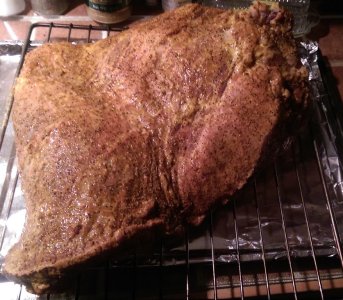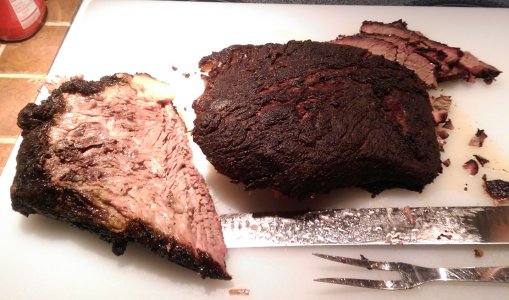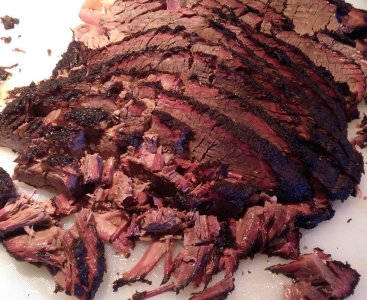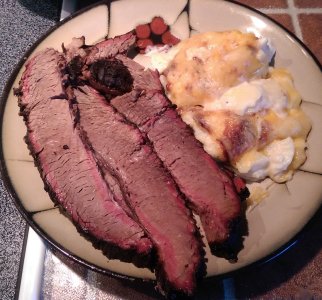DivotMaker
New member
This 11.55 lb packer cut brisket (point and flat) started yesterday morning, with a swim in my pork butt brine (Brine for Boston Butt). Had I had the time, I would have made up an equilibrium brine, but I time was one ingredient I was short on.
The brisket was a USDA Select, at $3.28/lb. Ouch. I used to get Choice, or even Prime for that price! This was my first smoke of a Select-grade brisket. The brine (with 1 Tsp. of #1 Instacure added) was ready at 11 a.m. yesterday, and the little briskie couldn't wait to take a swim!
This morning, I had a 1 a.m. wake-up call to get that little jewel in the #2! I removed it from the brine, and rinsed it thoroughly (I always recommend this with brined meat, just to get the excess surface salt off). Patted dry, it was slathered with yellow mustard and Jim Baldridge's Secret Seasoning (I love this on brisket).
Off to the smoker, where it found 6 oz. of mesquite/hickory, and a mini-loaf pan of apple cider. The Auber was set to 225° until IT hit 190°, then 140° for 4 hours (hold). The temp probe was inserted in the thick part between the point and flat, with the tip in the flat. Brisket was placed fat-side down. Fat-side down is a departure from how I normally do them; the rationale was that the fat cap would protect the flat from the smoke box heat, as there was virtually no fat on the bottom of the flat. You can see, in the first pic, that it was a little long for the 15" #2 shelf, so I just curled the end of the flat over. You can do this, because it will flatten as the meat shrinks. This is also the second time I've foiled the bottom of my 2 wood chunks, as I'll be going straight to smoking temp.
1:30 a.m., meat on and back to bed!
At 7 a.m., the meat was at 169°, and the smoke was thin. By 7:30, the meat hit 176° and was beginning to stall. The stall at 176° lasted for the next 4 hours, and even dropped back to 174°! Once it climbed out of the stall, it hit a secondary stall at 185° for over an hour. This really isn't uncommon for large cuts, so don't freak out if it happens to you. Just when you think "I only have 5° left, this won't take long!," is when Murphy rears his ugly head and says "Not so fast!" So, 1.5 hours for that last 5°!
At 190°, I wrapped in foil and placed in the cooler for a rest (2:30 p.m.). This was just over 1 hour per pound. No 20-hour brisket here!
After a 2-hour rest, the brisket was sliced. I removed the point for later (burnt ends), and sliced the flat. The flat was very tender (too soft to slice, even with a very sharp knife)! The very end of the flat (about 1") was too done, but that's to be expected.
I only brined this one, and did not use my usual injection. Results: The brisket was very tasty and tender, but could have been a tad more moist. Although, it was a moist as any restaurant brisket I've ever had (I'm demanding). But, it was melt-in-the-mouth tender! The Baldridge seasoning added just the right amount of flavor to the well-developed bark. The butt brine also added a sweet "faux" smoke ring, and added some great taste to the meat. This will be my standard, from now on.
Next time, I want to combine brining and injecting, to see if it is better. All in the name of science, of course! ;D
The brisket was a USDA Select, at $3.28/lb. Ouch. I used to get Choice, or even Prime for that price! This was my first smoke of a Select-grade brisket. The brine (with 1 Tsp. of #1 Instacure added) was ready at 11 a.m. yesterday, and the little briskie couldn't wait to take a swim!

This morning, I had a 1 a.m. wake-up call to get that little jewel in the #2! I removed it from the brine, and rinsed it thoroughly (I always recommend this with brined meat, just to get the excess surface salt off). Patted dry, it was slathered with yellow mustard and Jim Baldridge's Secret Seasoning (I love this on brisket).
Off to the smoker, where it found 6 oz. of mesquite/hickory, and a mini-loaf pan of apple cider. The Auber was set to 225° until IT hit 190°, then 140° for 4 hours (hold). The temp probe was inserted in the thick part between the point and flat, with the tip in the flat. Brisket was placed fat-side down. Fat-side down is a departure from how I normally do them; the rationale was that the fat cap would protect the flat from the smoke box heat, as there was virtually no fat on the bottom of the flat. You can see, in the first pic, that it was a little long for the 15" #2 shelf, so I just curled the end of the flat over. You can do this, because it will flatten as the meat shrinks. This is also the second time I've foiled the bottom of my 2 wood chunks, as I'll be going straight to smoking temp.
1:30 a.m., meat on and back to bed!
At 7 a.m., the meat was at 169°, and the smoke was thin. By 7:30, the meat hit 176° and was beginning to stall. The stall at 176° lasted for the next 4 hours, and even dropped back to 174°! Once it climbed out of the stall, it hit a secondary stall at 185° for over an hour. This really isn't uncommon for large cuts, so don't freak out if it happens to you. Just when you think "I only have 5° left, this won't take long!," is when Murphy rears his ugly head and says "Not so fast!" So, 1.5 hours for that last 5°!
At 190°, I wrapped in foil and placed in the cooler for a rest (2:30 p.m.). This was just over 1 hour per pound. No 20-hour brisket here!
After a 2-hour rest, the brisket was sliced. I removed the point for later (burnt ends), and sliced the flat. The flat was very tender (too soft to slice, even with a very sharp knife)! The very end of the flat (about 1") was too done, but that's to be expected.
I only brined this one, and did not use my usual injection. Results: The brisket was very tasty and tender, but could have been a tad more moist. Although, it was a moist as any restaurant brisket I've ever had (I'm demanding). But, it was melt-in-the-mouth tender! The Baldridge seasoning added just the right amount of flavor to the well-developed bark. The butt brine also added a sweet "faux" smoke ring, and added some great taste to the meat. This will be my standard, from now on.
Next time, I want to combine brining and injecting, to see if it is better. All in the name of science, of course! ;D






